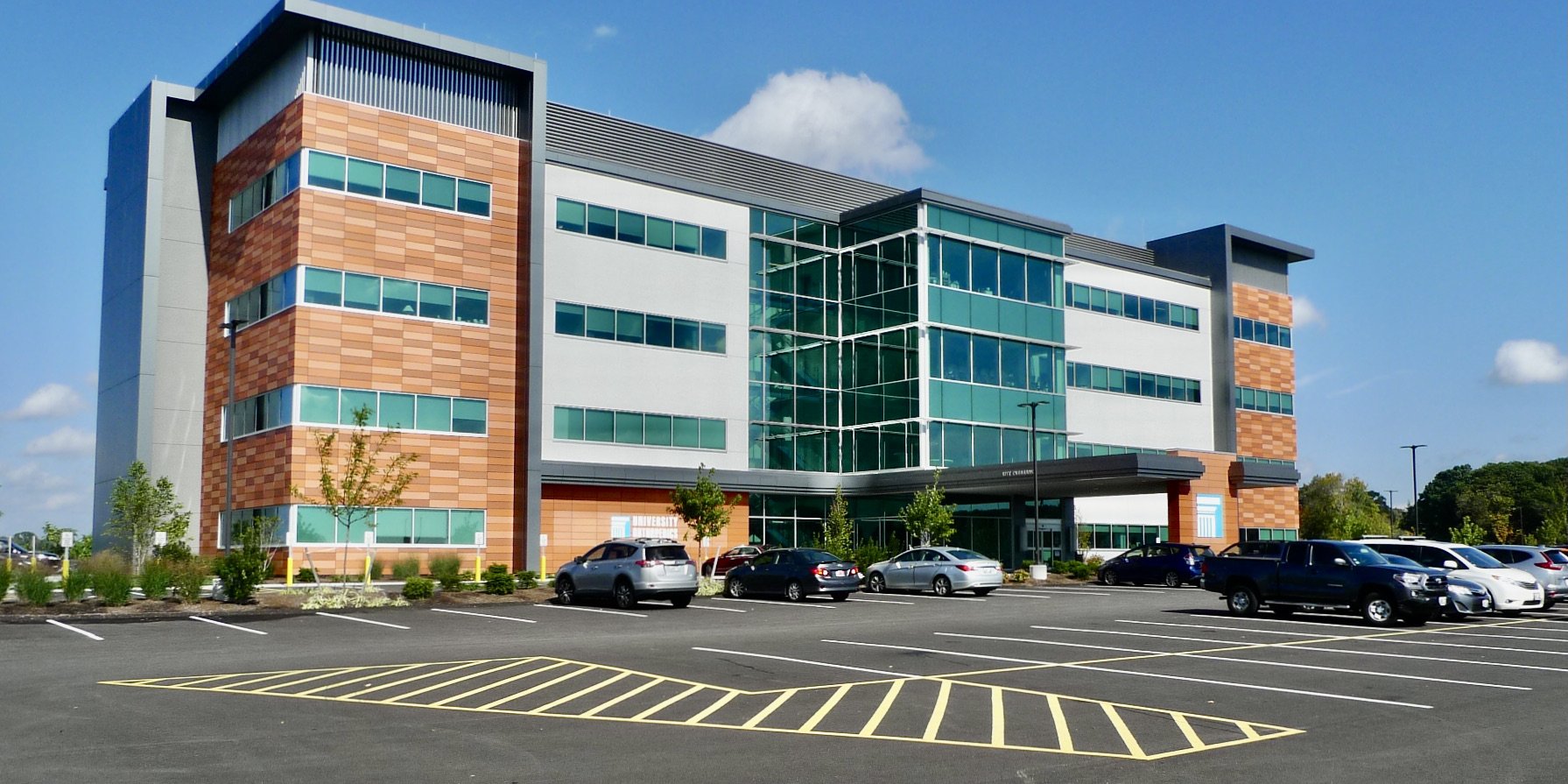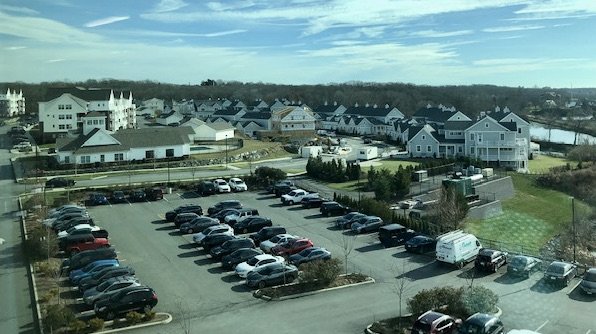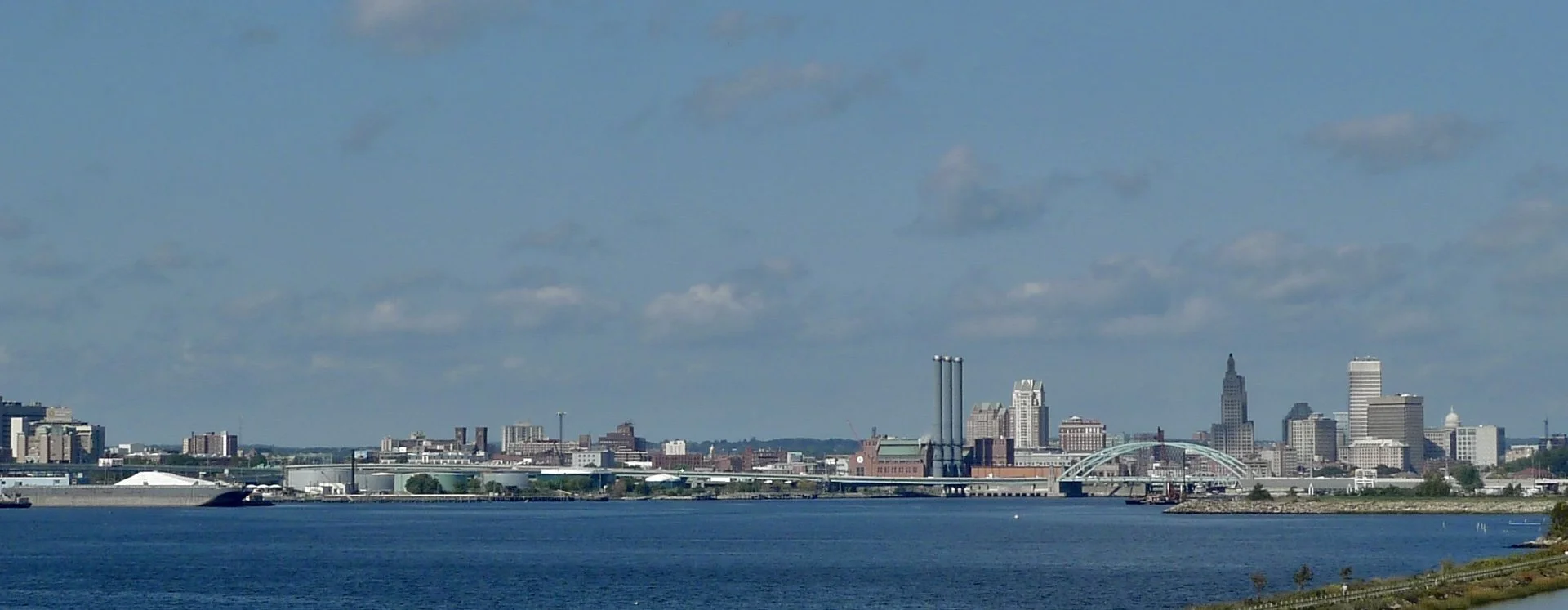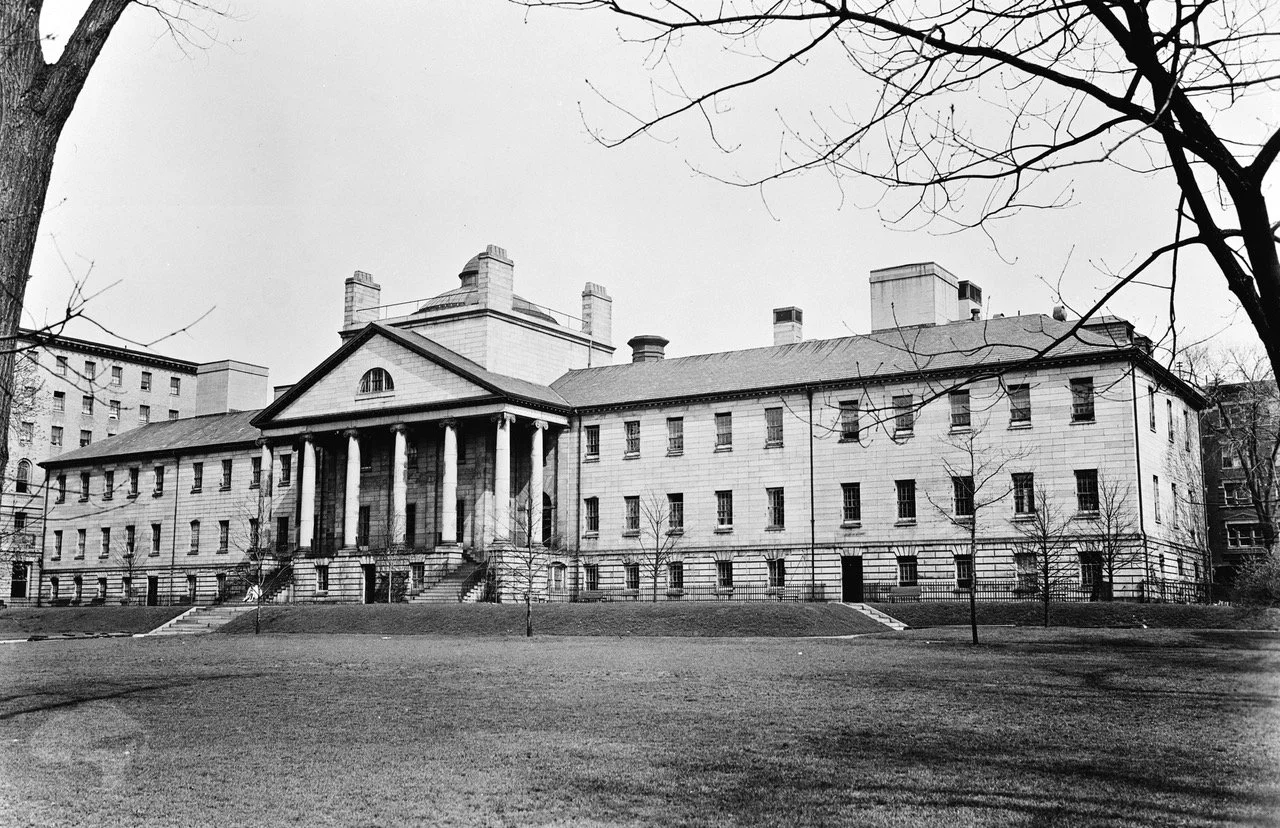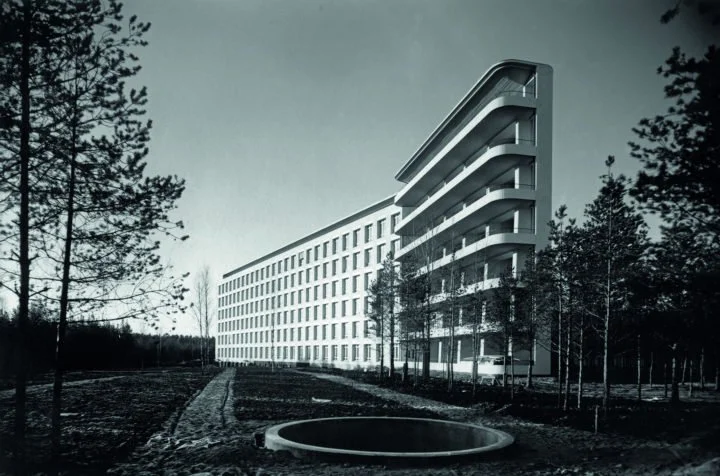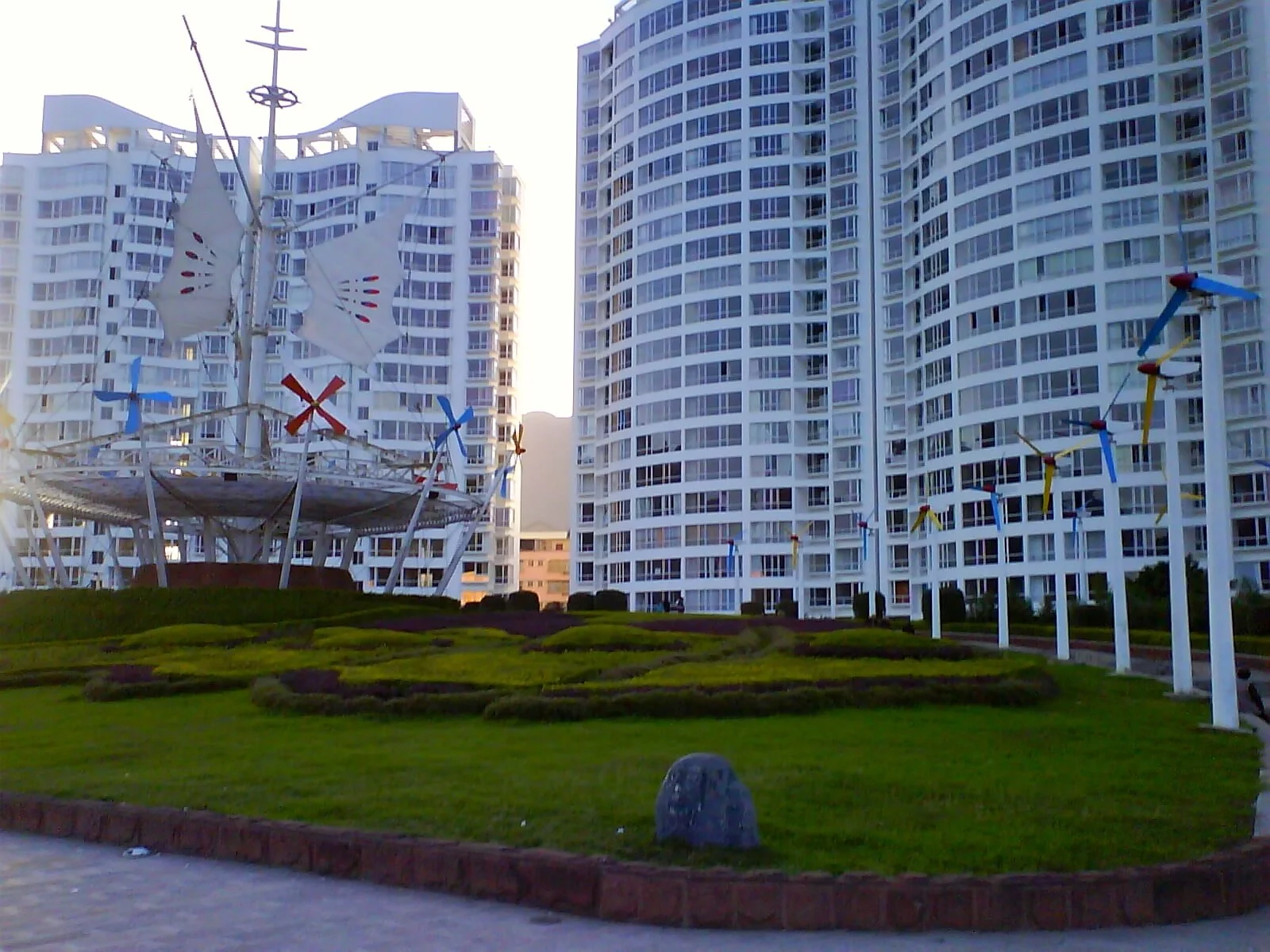
William Morgan: A medical firm’s lost design opportunity in a very dramatic spot
When can a substandard commercial building be transformed into good architecture? Can a despised icon of second-rate design become a beloved object? More specifically, can the ugly behemoth of University Orthopedics, in East Providence, R.I., overcome the stigma of being just another spec medical box?
University Orthopedics, 1 Kettle Point, East Providence, N/E/M/D Architects.
Photo by William Morgan
Kettle Point, which is also the site of a development of the kind of suburban housing seen near urban interstates everywhere, is a gorgeous promontory with unparalleled views of the Providence skyline, a working waterfront and down Narragansett Bay. If this site were not in the perceived ugly step-sister of East Providence, it would have been one of the most desirable pieces of land in the state. One thinks of what will happen to the neighboring Metacomet Golf Club course, glorious open land with tremendous potential: It will turn into the all-too-familiar faux-Colonial tackiness on a sea of asphalt.
Kettle Point housing development.
— Photo by Will Morgan
On the positive side, University Orthopedics is affiliated with Brown University’s Warren Alpert Medical School and so is one of the parts of Providence’s growing importance as a medical center. And the Kettle Point location offers expansive and maybe healing views of water, trees and skyline. This giant infusion of sunlight and a panorama of nature must surely contribute to the wellness of the patients and the happiness of the staff.
Providence harbor and downtown skyline from Kettle Point.
— Photo by William Morgan
The ugly duckling becomes a swan when a loved one needs treatment for osteoporosis or a broken limb. Then the state-of-the-art facilities and the staff’s training seem more important than aesthetics. But do they need to be mutually exclusive? What if the medical group that commissioned 1 Kettle Point had hired someone besides a value-engineering-minded developer? At the very least, a location this visible demanded a better design than a clunky real-estate container wrapped in cheap materials, one that looks like every other new medical office block from Boise to Little Rock.
Does this signage or the Home Depot-orange cladding symbolize quality medicine and research?
— Photo by William Morgan
A sensitive architect might have at least given 1 Kettle Point a more distinctive skyline. (Please do not whine that a good architect costs too much, as a really smart designer might have even given University Orthopedics a lot more for less.) And given such an environmentally sensitive site, a landscape architect should have been consulted, and maybe allowed to integrate this hulk into its prime surroundings.
Alas, the response in our high-quality (for those who can access it) but often unobtainable, fragmented and even chaotic American health-care system to such concerns is always one of money. What a building looks like seems minor compared to the medicine it delivers. But why not heal the entire patient, while at the same time supporting a quality building that could have been a great advertisement for the practice, for Brown, for Rhode Island?
The handsome lights on the stair compliment the undoubtedly unintentional industrial aesthetic of the metal railings.
— Photo by Will Morgan
Hospital needs, admittedly, dictate their forms. Think of all the university-affiliated and other medical centers that keep spreading across America, with new wings and additions, often in disparate styles. Yet, a handsome example that exists within the jumble of buildings that comprise the main campus of the august Massachusetts General Hospital, in Boston, is the handsome neoclassical original building, designed by Charles Bulfinch. In erecting their signature structure, the hospital trustees chose the architect of both the Massachusetts State House and the U.S. Capitol.
Massachusetts General Hospital, Charles Bulfinch, architect, 1818-23. Wikimedia Commons.
My favorite example of a successful hospital that is also a work of architecture is a tuberculosis sanatorium in rural Finland, designed in 1929 by a then-young Alvar Aalto. Built with limited resources, the sanatorium launched Aalto’s career, but it also became one of the noblest landmarks of modern architecture. The revolutionary aspects of the design were dictated by the treatment of TB, which emphasized abundant sunlight and fresh air. Aalto fashioned draft-less windows and splash-less sinks, along with bright colors and inexpensive furniture that is still being manufactured.
Tuberculosis sanatorium, Paimio, Finland, 1929-33.
— Photo by the Alvar Aalto Foundation.
Why should what University Orthopedics looks like, and how it contributes to or detracts from its environment, be any less important than the layout of its labs and operating rooms? This medical group, presumably, would not accept low professional standards of medicine. So, it is unfortunate that, in the quest for medical integrity, University Orthopedics’ patronage did not aspire to high standards of architectural design
William Morgan has taught the history of modern architecture at several colleges, including Princeton and Roger Williams Universities, and has written extensively on Finnish architecture.
Frank Carini: In two areas on R.I. coast — improvement and new challenges
The Nature Conservancy and its partners installed a living shoreline at Rose Larisa Memorial Park, in East Providence, to help keep coastal erosion at bay.
— Photo by Frank Carini/ecoRI News)
From ecoRI News (ecori.org)
EAST PROVIDENCE, R.I.
Growing up in the 1970s and ’80s across the Seekonk and Providence rivers in Rhode Island’s capital, John Torgan spent plenty of time exploring the state’s urban shoreline.
He remembers them as dumps filled with sewage and littered with decaying oil tanks.
“They were horribly polluted,” said Torgan, who still lives in Providence. “No one was fishing or sailing.”
His childhood memories, however, also include the beauty of a peaceful island in the middle of a shallow 4-mile-long salt pond.
The fortunes of these waters and their surroundings have changed since an adolescent Torgan, now 51, was skipping rocks, collecting shells and investigating the coastline for marine life. The Providence and Seekonk rivers are still impaired waters, but, like the chain-link fence topped with barbed wire that once separated much of these waterways from the public, the derelict oil tanks have been removed. The rivers’ health has improved.
The two rivers, both of which share a legacy of industrial contamination and suffer from stormwater-runoff pollution, aren’t recommended for swimming, but life on, under and around them has returned. Menhaden, bluefish, river herring, eels, osprey and cormorants are now routinely spotted. The occasional seal, dolphin, bald eagle and trophy-sized striped bass visit. Kayakers, fishermen, scullers and birdwatchers are easy to find.
Torgan, who spent 18 years as Save The Bay’s baykeeper, called the comeback of upper Narragansett Bay “extraordinary” and “dramatic.” He credited the Narragansett Bay Commission’s ongoing combined sewer overflow project with making the recovery possible.
As for that summer cottage on Great Island in Point Judith Pond, he said “tremendous development” has changed the neighborhood. Bigger houses now surround the Torgan family’s saltbox cottage, adding stress to one of Rhode Island’s largest and most heavily used salt ponds.
There is a diverse mixture of development around the shores of the pond that straddles South Kingstown and Narragansett. In the urban center of Wakefield, at the head of the pond, and at the port of Galilee at its mouth, there is an abundance of commercial development and a corresponding amount of pavement. The impacts are beginning to show.
Early last year the Rhode Island Department of Environmental Management decided, based on ongoing water-quality monitoring results, to reclassify two areas of Point Judith Pond from approved to conditionally approved for shellfish harvesting. Water samples collected in the pond after certain rain events showed elevated bacteria levels and resulted in several emergency and precautionary shellfishing closures.
An underappreciated coastline
As an adult, Torgan’s interest in and passion about the marine environment hasn’t waned. The avid boater and angler has spent much of his working life protecting the Ocean State’s namesake, especially the waters not typically associated with its catchy moniker.
“This is the coast,” Torgan said while standing at the water’s edge at Rose Larisa Memorial Park. “The coast of Rhode Island doesn’t start at Rocky Point. It’s not just the beaches of South County.”
But, like most of the state’s coastline, the East Providence shoreline is vulnerable to accelerated erosion driven by the climate crisis and growing development pressures. Like much of the state’s urban shoreline, the health of this stretch of beach is better but hardly pristine. It is littered with chunks of asphalt and broken glass, most of its sharp edges dulled by tumbling in the sea. Swimming isn’t advised.
The climate challenges and improved health are why the organization Torgan currently heads, the Rhode Island chapter of The Nature Conservancy, took an interest in protecting this underappreciated stretch of beach.
More frequent and intense storms, combined with increasing sea-level rise, are eroding beaches and bluffs and damaging the state’s diminishing collection of coastal wetlands. Torgan said dealing with the negative impacts of this reality, plus increased flooding, is a huge challenge for Rhode Island’s 21 coastal communities. He noted adequately supported coastal resiliency projects that use nature are needed to inoculate the state against the changes that are coming.
To that end, The Nature Conservancy partnered with the Coastal Resources Management Council (CRMC) and the City of East Providence last year to test the effectiveness of “living shoreline” erosion controls at the popular Bullocks Point Avenue park.
The park’s steep coastal bluff rises 20-30 feet above a narrow beach. In several areas, however, erosion has crumbled sections of the bluff, exposed root balls and felled trees. Previous efforts to reduce erosion through human-made practices, such as the installation of riprap and seawalls, failed.
As its name suggests, the living shoreline model incorporated more natural infrastructure. Unlike concrete or stone seawalls, living shorelines are designed to prevent erosion while also providing wildlife habitat. Hardened shorelines, compared to living ones, also diminish public access.
The first step in returning nature to a prominent role at this coastal park, at the head of Narragansett Bay’s tidal waters, was removing debris, such as large concrete slabs more than 20 feet long that were sitting at the bottom of the bluff, left behind by those failed human attempts to keep Mother Nature at bay.
Then, at the northern end of the park, the bank was cut away to reduce the slope. Stone was placed at the base of the bluff and logs made of coconut fiber were installed farther up the slope. The bluff was planted with native coastal vegetation. Near the southern boundary, low piles of purposely placed rocks and rows of beachgrass and native plants were added.
In other areas along this stretch of upper Narragansett Bay beach, boulders, cement walls and wooden structures, to varying degrees of success, strain to keep East Providence backyards from eroding and the bay from encroaching.
“As a matter of policy, we need to change our relationship with water where we’re not trying to hold it back and keep it out,” Torgan said. “In a more comprehensive way, think about how can we manage it and create basins where we are welcoming the water. That will help with flooding. It will help with sea-level rise and storm damage. It will improve water quality. The long view is changing the mindset that says we need to wall off the rising water and instead think about natural approaches and strategies that allows us to move with it.”
He noted that while living shoreline techniques have been implemented elsewhere in the United States, few have been permitted, built and evaluated in New England. He said small-scale projects like this one give coastal engineers and coastal permitting agencies a better sense of their cost and effectiveness, most notably in areas that aren’t exposed to open-ocean shoreline, like along much of the South Coast, where these artificial marshes would likely be unable to blunt stronger wave action.
When the 2020 project was announced, CRMC board chair Jennifer Cervenka said, “Much of Rhode Island’s coastline is eroding, and it’s a problem with no easy fix. This nature-based erosion control is one of the first of its kind in Rhode Island, and New England. We can’t stop erosion completely, but living shoreline infrastructure like this might buy our shores some valuable time.”
The project, which cost about $230,000, was funded by a Coastal Resilience Fund grant from the National Oceanic and Atmospheric Administration, The Nature Conservancy, the Newport-based foundation 11th Hour Racing and the Rhode Island Coastal and Estuarine Habitat Restoration Trust Fund.
Frank Carini is editor of ecoRI News.
Green energy here and there
From Robert Whitcomb’s “Digital Diary,’’ in GoLocal24.com
I think that much of the future of alternative green energy will be in small-scale, “distributive energy” projects, such as the small wind turbines that the Bank of America wants to put up at 3400 Pawtucket Ave., in East Providence. As these proliferate, electricity-generation by big regulated utilities will become less important.
We’ll get increasingly used to seeing solar-energy arrays and small wind turbines in parking lots and on roofs of office buildings, factories and apartment buildings all over the place.
Suntactics dual axis solar trackers are useful for small businesses.
— Photo by Adsala
The Silver Age
Looking across the head of Narragansett Bay to Providence from the East Providence shoreline.
— Photo by William Morgan
Of fading old clubs and three martinis
The 10th hole at the Metacomet Golf Club
From Robert Whitcomb’s “Digital Diary,’’ in GoLocal24.com
Nearby, in East Providence, and on higher ground, is the lovely Metacomet Golf Club, which has been in a financial crisis, and apparently is being sold to a development company called Marshall Development. That firm plans to turn the site into a mixed-use property. Might that include a gated community? How about with a nine-hole golf course? A three-hole one? A putting green?
Metacomet encompasses 105 acres – lots of open land to play with!
Fewer people seem to have the time or the inclination these days to spend the hours necessary to play 18 holes anyway. And golf is a very expensive sport.
Further, the population is aging. Even with golf carts, there are more and more people for whom even golf is physically too much.
And America has a housing shortage. A lot of that land now taken up by golf courses is enticing to build on. After all, the land is mostly open.
Other old clubs, usually originally created primarily for men, also are struggling. Fewer successful people can, or want to, take the time for a leisurely lunch, and it’s long been unfashionable to drink at lunch. That activity used to be major attraction of club lunches. But tax changes under Reagan and Bill Clinton reduced the deductibility of what used to be called “the three-martini business lunch.’’
I remember with a pang the boozy “business” lunches I had in New York and Paris; I usually drank little or nothing, but most of my table mates knocked back the stuff. One of these people offered me a job, which I took. Later on, one of my bosses in Paris insisted on my joining him for frequent vinous lunches at a restaurant near the office to “plan.’’ I’d be lucky to escape in two hours to rush back to my deadline work. Toward the end of the meal, the very patient waiter would ask my boss “Another Irish {coffee), monsieur?’’=
When back in the early ‘70s, I was briefly an intern at Business Week magazine, in New York, two editors took me to lunch several times at a famous restaurant called Sardi’s. They always ordered a bottle of wine, and one of them a cocktail. Then, after an hour-and-half lunch, we’d straggle back to the office, where one of them, the executive editor, would light his pipe and run the daily editors meeting with great skill and astonishing memory for economic data. The other went to sleep in his office.
But the most impressive three-martini lunch man I broke bread with was a college classmate and an account executive for a big ad agency who seemed to spend most of his waking hours in overpriced Manhattan restaurants. He often paid for our lunches on his expense account, although as a young newspaper editor I was in little position to help his agency. “Let’s just call it business development,’’ he told me.
It was all very unhealthy but often great fun.
